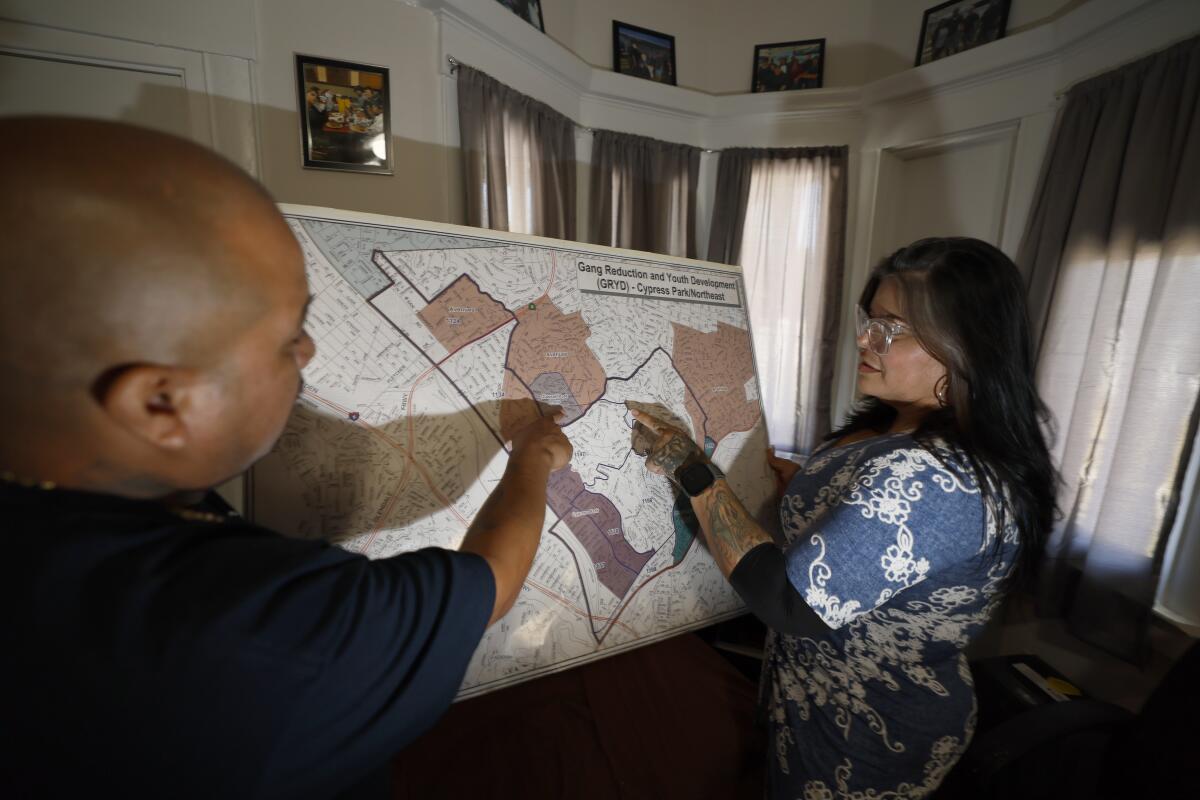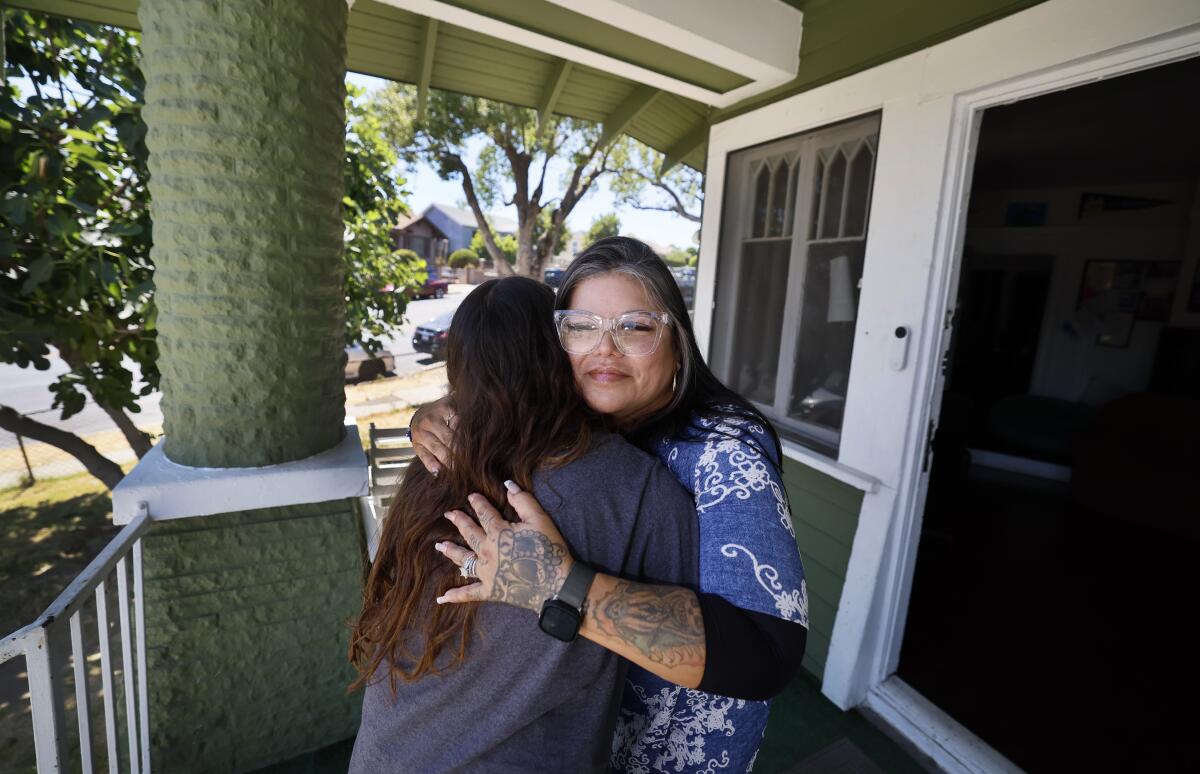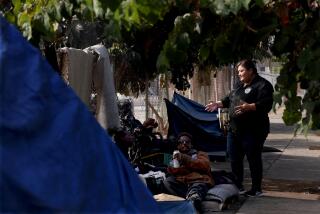L.A. gang interventionists got better pay. They’re still searching for respect.

- Share via
How much is a life saved in Los Angeles worth?
It’s a question that kept crossing Tina Padilla’s mind when she heard officials praise the work of gang interventionists. Described by some city leaders as an integral part of crime reduction efforts, interventionists are equal parts social worker, mediator, and life coach, often using their lived experiences and connections as former gang members to squash beefs and avert violence.
By the city’s metrics, they are delivering results. At a presentation in June, officials pointed to steep crime reductions over the past year in the city’s 23 so-called gang reduction zones, where interventionists are active. Homicides in those areas plummeted by 21%, while the number of attacks on police officers, criminal threats and non-fatal shootings also decreased by double-digit percentages. And there seemed to be a ripple effect citywide, where gang slayings were down 26% compared with last year.
But when it came to getting paid, most interventionists Padilla knew were lucky to earn $40,000 in a year before taxes — chump change by L.A. standards. Last summer, the city raised the minimum salary for sanctioned peacemakers who complete special training to $60,000 — still relatively low in an area with a sky-high cost of living, Padilla says.
While lobbying the City Council to release funding allocated for the raises from the city’s “unappropriated balance,” one interventionist testified that he had to take on a second job just to get by.

“It’s just flat-out wrong that I make $1 more than a person who works at McDonald’s, but $2 less than a person who works at In-N-Out, and I save lives every day,” one man told members of the public safety committee, drawing applause from the room.
In the L.A. gang intervention world, the pay raise was met with cautious optimism, after years of what some saw as empty promises and hollow rhetoric from City Hall.
Mayor Karen Bass campaigned on rebuilding the LAPD’s ranks, while also investing in violence prevention programs and alternatives to police for nonviolent, noncriminal calls for service.
For the record:
5:33 p.m. Aug. 1, 2024An earlier version of this story misspelled the first name of interventionist Melvyn Hayward as Melvin.
Under Bass, the city’s Office of Gang Reduction and Youth Development, or GRYD, has seen its budget grow to $42 million, its efforts bolstered by funding from private philanthropic organizations such as the Ballmer Group. Interventionists, including Padilla, praised Bass for appointing one of their own to run GRYD, in Melvyn Hayward, a longtime and respected interventionist.

“Not that we weren’t listened to before, but I feel like it’s more in the spotlight now,” said Padilla, of the outreach group Community Warriors 4 Peace. “For me that’s huge, because Melvyn is boots on the ground, he’s a practitioner, and he has lived experience.”
She also saw promise in Bass’ creation of a standalone Office of Community Safety, aimed at developing new strategies for keeping the city safe that go beyond traditional law enforcement. Now in its second year, the office has worked on securing funding and distributing it to the network of nonprofits that oversees the city’s gang intervention and anti-violence programs.
With the additional resources, the intervention workforce is expected to grow by 25%.
The help couldn’t come at a better time, says Padilla, whose six-member team based in Northeast L.A. has been stretched thin. She said she needed to hire more staff to keep up with the changing demands of the job.
Interventionists are still doing what they’ve always done: preventing retaliatory violence by tamping down rumors and connecting gang members with social services — all while grappling with the traumas of their past lives. But, at the height of the pandemic, they turned into frontline healthcare workers in their neighborhoods, passing out masks and educating people about the coronavirus.
Keeping up with the city’s changing gang landscape, which has become fractured and less hierarchical, is trickier than ever. Gang membership changes often, sometimes week-to-week. Infighting has grown more common. Violence is just as likely to be the result of interpersonal dramas over a romantic partner or a perceived slight on social media than someone’s affiliation.
As housing costs soared across the city, many of the people targeted with intervention efforts were forced to relocate out of L.A. during the pandemic, moving to places like Palmdale, Lancaster and Victorville. Staying connected proved challenging, particularly for especially to those who still returned to their old neighborhoods in the city on the weekends and occasionally got into trouble.
“How do we service those ‘weekend warriors,’ who are coming in and causing a ruckus?” she said. She also struggles with finding help for older gang members who have aged out of certain services because they are coming out of prison after serving sentences extended by gang enhancements.
Los Angeles is one of many cities nationwide doubling down on gang intervention. Although versions of the strategy have existed for decades, the approach gained even wider acceptance amid the national reckoning on race and policing that emerged after the 2020 police murder of George Floyd in Minneapolis. The following year, the U.S. Justice Department announced $444 million in grants for violence reduction, including intervention programs.
In an interview with The Times, Bass said she sees interventionists as crucial to the city’s crime reduction efforts.
“I felt like it had really kind of fallen by the wayside a bit and become more generalized citywide, as opposed to targeted in the areas that were most at risk,” Bass said. “Some areas of the city do not need these programs. And if you try to do things citywide, then you deplete the resources where the areas that need these programs that most need concentrated services.”
Behind the scenes, the city’s office that oversees L.A.’s vast network of gang prevention and intervention programs was in disarray for years, say Padilla and others. Staffers quit, and weren’t replaced. City-sanctioned trainings ceased for several years.
The emphasis seemed to shift to “case management” over “prevention and intervention,” said Fernando Rejón, executive director of L.A.’s Urban Peace Institute, a coalition of interventionist groups.
In response, he said, groups released a public safety plan of its own that called for hiring up to 500 peacemakers, forming partnerships with area trauma centers and reinvesting “in the family-systems approach to violence prevention.”
“So there was a lot of gaps that existed that were not addressed by the previous administration, just a matter of a lack of innovation and a lack of political will to do so,” he said. “There was more of an emphasis on meetings with LAPD than there was on field intervention.”
Pastor Tyrice Cagle of Strong Shoulders Ministry said that much of intervention work happens outside of the public’s view, and cannot always be measured. And while intervention workers and police each harbor a certain distrust of one another, he thinks that both groups have a role in keeping city streets safe.
“We’re doing the same thing of trying to save lives and stop the next retaliation,” Cagle said.
Violence remains a problem in certain communities. Recent spasms of bloodshed on the city’s South End have been blamed on simmering conflicts between the 8-Trey Hoovers and the Neighborhood Crips in one area, and between the Main Street Crips and the Swans in another, police say. Other incidents, such as the January shooting of the daughter of a well-known East Coast Crips member, possible retaliatory violence, police said.
Beyond seeking better pay, interventionists also want respect. Some rank-and-file police officers remain leery of working too closely with outreach workers who still have one foot in the street life. In the past, police said, sensitive information passed to certain workers sometimes found its way into the hands of active gang members. On YouTube, some critics have posted videos that question whether certain interventionists are working as police informants, or dismiss them as out-of-touch charlatans who chase city contracts by overstating their street credentials and ability to connect with a younger generation.
At the same time, several high-profile intervention workers have been charged with serious crimes, making it even tougher for those now doing honest work to shake the stigma of their past life.
In past eras, such programs have been magnets for criticism, with several city audits uncovering millions of dollars spent on unproven programs and failures to coordinate with schools, law enforcement and social agencies. Some of those concerns resurfaced during recent Council committee meetings.
The city has for years sought to professionalize the ranks of interventionists, providing new oversight and training. Several intervention academies have sprung up, and city leaders have sought to hold peacemaker agencies accountable by using “evidence-based” tracking of gang-related violence andreferrals into job training programs and other services.
Karren Lane, the city’s deputy mayor of community safety, said her office has focused on crime prevention through beefing up the ranks of unarmed crisis responders, including interventionists.
The city is also making investments in “comprehensive reentry services,” including housing, mental health support, job placement and job training with input from interventionists, Lane said.
“We don’t just wanna say, ‘Do more, do more,’” she said. “We wanna say, ‘Do more, but let us help you do more.’”
More to Read
Sign up for Essential California
The most important California stories and recommendations in your inbox every morning.
You may occasionally receive promotional content from the Los Angeles Times.











